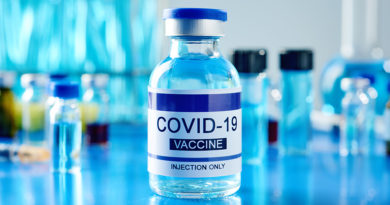Fact Check: Military-funded sensor can help detect COVID-19, but it’s not a microchip
The claim: A new Pentagon microchip can tell if you have COVID-19
A Facebook post with nearly 4,000 shares and reactions claims the Pentagon has developed a microchip implant, equipped with an antenna, capable of detecting a COVID-19 infection.
“What started off as a conspiracy theory has turned out to be surprisingly real,” reads the April 12 post from Russia Today, a page Facebook flags as state-controlled media. “Pentagon scientists have unveiled a microchip implant which can detect a Covid-19 infection. The chip, which is equipped with a small antenna, is meant to act like a ‘check engine’ light, catching asymptomatic cases of the disease.”
The claim comes after a “60 Minutes” segment posted online on April 11, which featured retired Col. Matthew Hepburn, a former military infectious disease physician who is now a project leader at the Joint Program Executive Office for Chemical, Biological, Radiological and Nuclear Defense.
During the interview, Hepburn described a sensor that can detect if a person is getting sick, which has been in the making since 2016 and could be repurposed from its original use to help detect early cases of COVID-19 and other illnesses.
Sensor is inert, not a microchip
The Facebook post gets several details wrong.
The green sensor, which is smaller than a grain of rice, is not a microchip. It doesn’t have any metal or electronics, according to Profusa, the company that received $7.5 million in federal money in 2016 to develop the sensor. Their original goal was to monitor a combat soldier’s health in real-time in active combat zones.
The sensor, first publicized in 2018, is made of hydrogel similar to the tissue found around the arm, where the sensor is placed under the skin by injection, according to Profusa. It is under testing for potential military applications but is not yet in use, Hepburn said.
“Profusa’s technology is not a hydrogel chip that will connect you to the Internet,” Jared Adams, chief of communications for the Defense Advanced Research Projects Agency told USA TODAY in an email. “The Profusa hydrogel is inert, does not have any electrical components, and is of similar material to a contact lens or corneal implant.”
Fact check: Minnesota police association covering Chauvin’s defense, not Trump
The sensors contain light-emitting fluorescent molecules that identify and keep track of oxygen, glucose, lactate and other biomolecules in the body. If those increase or decrease, it could indicate the person is getting sick and might show symptoms soon.
Those changes are recorded through another device, a reader, worn on the skin’s surface or held by hand directly on top of the injected sensor. The reader sends signals through the skin to the sensor, which emits light signals with real time information about the biomolecules present.
The information collected by the reader is displayed on an encrypted phone application via Bluetooth, said Adams. Profusa said that data can be shared with health care providers as well.
Sensor not made for COVID-19 specifically
The sensor can be used as a “check engine light,” Hepburn told “60 Minutes.” Once the person knows they might show symptoms soon, they can take a test or do a blood draw and see what illnesses their bodies are reacting to.
While the sensor doesn’t directly treat COVID-19 or any other disease, it can provide early detection that allows faster intervention and treatment.
“As you truncate that time, as you diagnose and treat, what you do is you stop the infection in its tracks,” said Hepburn.
Our rating: Partly false
The claim that a sensor developed by Pentagon scientists is a microchip with an antenna that can detect COVID-19 is PARTLY FALSE, based on our research. The sensor is not a microchip, as it’s inert and doesn’t have any metal that could relay personal information to other devices. And it was developed by a private company, though using federal funding. The chip also doesn’t directly detect COVID-19, but it can relay information about changes in molecules that could indicate the presence of COVID-19 or other diseases.
Our fact-checking sources:
- “60 Minutes,” April 11, 2021, “Military programs aiming to end pandemics forever“
- Email interview with Jared Adams
- Profusa, March 19, 2018, “Injectable Body Sensors Take Personal Chemistry to a Cell Phone Closer to Reality“
- Profusa, July 12, 2016, “Profusa, Inc. Awarded $7.5M DARPA Grant to Develop Tissue-integrated Biosensors for Continuous Monitoring of Multiple Body Chemistries“
Thank you for supporting our journalism. You can subscribe to our print edition, ad-free app or electronic newspaper replica here.
Our fact check work is supported in part by a grant from Facebook.


